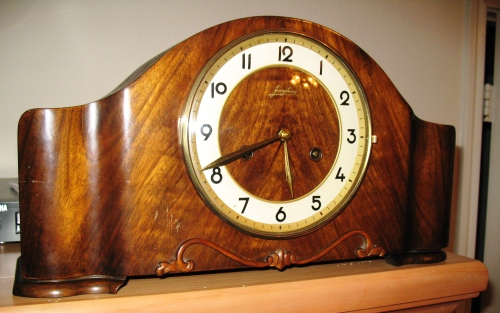‘Bim-Bam’ striking clock. 8 day.
The clock was very clean when I received it except that some grease or oil had hardened around a couple of the time train pivots causing the clock to stop intermittently.
 I recall feeling particularly lazy on the day I repaired this clock not wanting to do any more than the bare minimum to get the thing working. I dropped both the mainspring barrels out (easy on these newer designs) and pulled the plates apart just enough to clean the time train wheel pivots without disturbing the Strike side. The movement of this clock was extremely clean. It just goes to show how just a little thickened oil can cause a problem even when a clock looks a clean as a pin!
I recall feeling particularly lazy on the day I repaired this clock not wanting to do any more than the bare minimum to get the thing working. I dropped both the mainspring barrels out (easy on these newer designs) and pulled the plates apart just enough to clean the time train wheel pivots without disturbing the Strike side. The movement of this clock was extremely clean. It just goes to show how just a little thickened oil can cause a problem even when a clock looks a clean as a pin!


I have a german mantel clock and the mechanism looks similar to this clock, except there are two pins either side of the crutch as in your westminster chimes clock. Can you explain how to set the clock in beat please – the pins restrict my efforts to push the crutch either way. Do I loosen the two small screws that hold the bracket on which the crutch pivots? I am not very knowledgeable about these things. Thank you.
John Smith
Hi John,
Thank you for visiting our clock site. Sorry for the delay in replaying to your query.
No, do not loosen the two screws. They adjust the anchor that will adjust the distance from the pallets to the escape wheel. This generaly should not need to be adjusted.
I typically hold the anchor and adjust the crutch. They can be hard to move. Just be carefull that the anchor does not come into contact with the teeth of the escape wheel when you are doing this. I have also wedged a tooth pick in-between the escape wheel teeth and let the pallet sit on the wood of the tooth pick and moved the crutch. The tooth pick will help protect the pallets from hitting the escape wheel. Once the crutch initially moves, you’ll find it will be easier to adjust. Fine adjustement may require a slip of card under one side of the clock!
Hope this helps!
John followed up with the following question via email: You said that the anchor should not come into contact with the escape wheel – isn’t one of the anchor pallets always in contact with the wheel?
Our Reply: Yes, that’s true. You just want to make sure that one if the pallets doesn’t damage the escape wheel as you are making your adjustment because you may have to use quite a bit of force to do so.
If the movement is still in the clock, put your fingers over the top of the anchor to stop it rocking. Then, move the crutch and make sure nothing bangs against the escape wheel while you adjust the beat.
By supporting it with your fingers, you should be able to prevent this.
Some clocks don’t have those pins that limit how far the crutch can move. I know they are a bother. The main point is to stop the anchor rocking. But you should able to do it with your fingers.
I have a 1930 Junghan mantel clock with the same pendulum bob as the clock above. It has been in the family for 4 generations. Have had the clock fixed for 116.00 dollars. The bob appears to be damaged. Would you have any advice as to go about finding this particular bob?